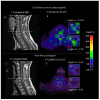Neuroinflammation at the Neuroforamina and Spinal Cord in Patients with Painful Cervical Radiculopathy and Pain-Free Participants: An [11C]DPA713 PET/CT Proof-of-Concept Study
- PMID: 40217878
- PMCID: PMC11989976
- DOI: 10.3390/jcm14072420
Neuroinflammation at the Neuroforamina and Spinal Cord in Patients with Painful Cervical Radiculopathy and Pain-Free Participants: An [11C]DPA713 PET/CT Proof-of-Concept Study
Abstract
Background/Objectives: The complex pathophysiology of painful cervical radiculopathy is only partially understood. Neuroimmune activation in the dorsal root ganglion and spinal cord is assumed to underlie the genesis of radicular pain. Molecular positron emission tomography (PET) using the radiotracer [11C]DPA713, which targets the 18-kDa translocator protein (TSPO), offers the ability to quantify neuroinflammation in humans in vivo. The primary objectives of this study were to (1) assess whether uptake of [11C]DPA713, a metric of neuroinflammation, is higher in the neuroforamina and spinal cord of patients with painful cervical radiculopathy compared with that in pain-free participants and (2) assess whether [11C]DPA713 uptake is associated with clinical parameters, such as pain intensity. Methods: Dynamic 60 min [11C]DPA713 PET/CT scans were acquired, and regions of interest were defined for neuroforamina and spinal cord. Resulting time-activity curves were fitted to a single-tissue compartment model using an image-derived input function, corrected for plasma-to-whole blood ratios and parent fractions, to obtain the volume of distribution (VT) as the primary outcome measure. Secondary neuroinflammation metrics included 1T2k VT without metabolite correction (1T2k_WB) and Logan VT. Results: The results indicated elevated levels of 1T2k VT at the neuroforamina (p < 0.04) but not at the spinal cord (p = 0.16). Neuroforamina and spinal cord 1T2k VT lack associations with clinical parameters. Secondary neuroinflammatory metrics show associations with clinical parameters such as the likelihood of neuropathic pain. Conclusions: These findings enhance our understanding of painful cervical radiculopathy's pathophysiology, emphasizing the neuroforamina levels of neuroinflammation as a potential therapeutic target.
Keywords: PET imaging; cervical radiculopathy; immunoactivation; neuroinflammation; neuropathic pain.
Conflict of interest statement
The authors declare no conflict of interest.
Figures


References
-
- Rihn J.A., Bhat S., Grauer J., Harrop J., Ghogawala Z., Vaccaro A.R., Hilibrand A.S. Economic and Outcomes Analysis of Recalcitrant Cervical Radiculopathy: Is Nonsurgical Management or Surgery More Cost-Effective? J. Am. Acad. Orthop. Surg. 2019;27:533–540. - PubMed
-
- Bogduk N. On the definitions and physiology of back pain, referred pain, and radicular pain. Pain. 2009;147:17–19. - PubMed
-
- Abbed K.M., Coumans J.-V.C. Cervical radiculopathy: Pathophysiology, presentation, and clinical evaluation. Neurosurgery. 2007;60:S1–S28. - PubMed
-
- Woods B.I., Hilibrand A.S. Cervical radiculopathy: Epidemiology, etiology, diagnosis, and treatment. J. Spinal Disord. Tech. 2015;28:E251–E259. - PubMed
Grants and funding
LinkOut - more resources
Full Text Sources

